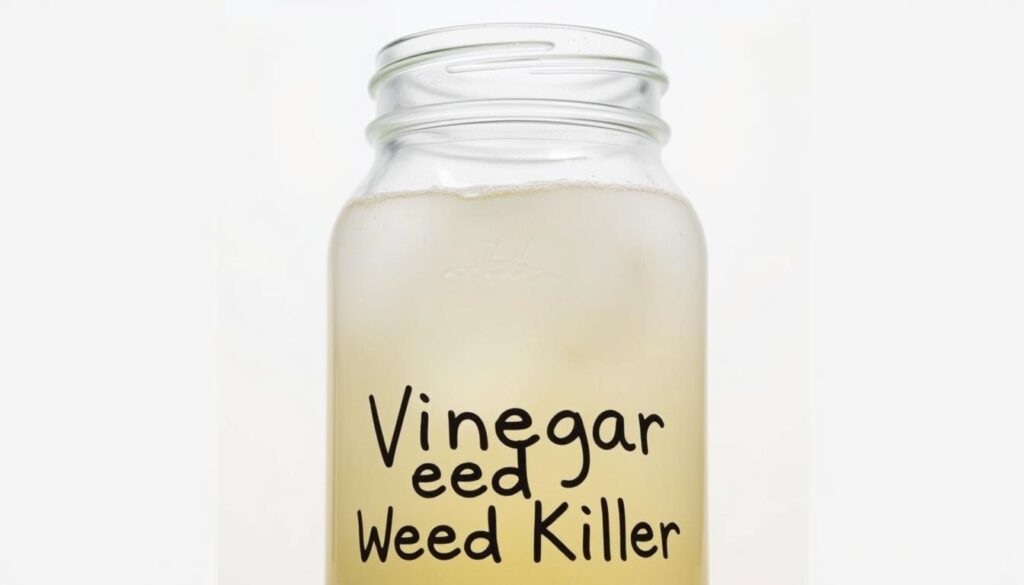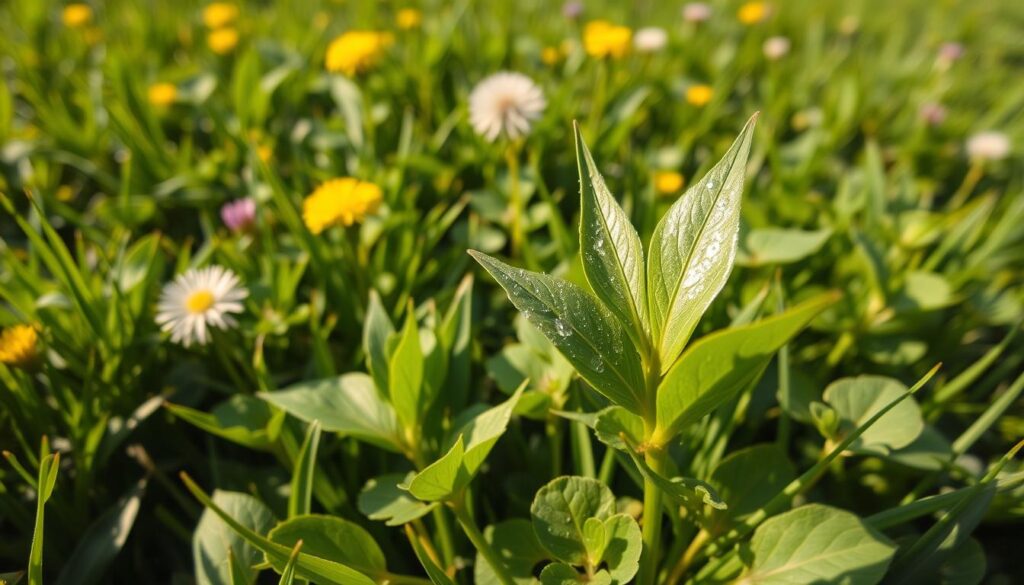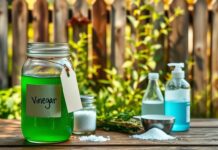DIY Weed Killer: Did you know that weeds can grow up to 2 inches in just 24 hours? This rapid growth can quickly overtake your garden, making it essential to act fast.
Fortunately, there’s a simple, natural solution that’s both effective and eco-friendly.
According to Stacy Ling, a gardening expert featured in USA Today, a mix of vinegar, salt, and dish soap can eliminate unwanted plants without harming the environment.
This method is particularly effective on patios and pathways, where synthetic herbicides might pose risks to nearby ponds and wildlife.
Rebecca Sears of Seeds of Change explains that the acetic acid in vinegar acts as a contact herbicide, breaking down cell walls and dehydrating weeds.
EPA data supports this, showing that this mix can remove weeds 20-30% faster than manual removal alone.
However, Craig Elworthy of Lawnbright warns that this solution is non-selective, meaning it will kill all plants it touches. So, careful application is key to protecting your desired vegetation.
Key Takeaways
- A mix of vinegar, salt, and dish soap is a proven natural weed killer.
- Stacy Ling recommends this method for patios and pathways to protect wildlife.
- Vinegar’s acetic acid breaks down weed cell walls, effectively dehydrating them.
- EPA data shows this method is 20-30% faster than manual weed removal.
- This solution is non-selective and will kill all plants it touches.
Why Choose a Homemade Weed Killer?
Natural solutions for weed control are gaining popularity for good reason. A homemade weed killer made from vinegar, salt, and dish soap is not only effective but also eco-friendly and pet-safe.
Unlike commercial herbicides, this mix avoids synthetic chemicals, making it a safer choice for your family and the environment.
Stacy Ling, a gardening expert, recommends this method for areas near ponds or wells to prevent contamination. She emphasizes its safety for wildlife and pets, especially in spaces where children and animals play.
Additionally, EPA data shows that acetic acid, the active ingredient in vinegar, decomposes 83% faster than glyphosate, a common chemical in commercial herbicides.
Cost is another major advantage. A gallon of this homemade weed killer costs just $0.25, compared to $15 or more for store-bought alternatives.
This makes it a budget-friendly option for organic gardening enthusiasts.
“A combination approach increases effectiveness by 40%,” says Eva Reutinger, a gardening specialist. This means adding salt and dish soap to vinegar enhances its weed-killing power.
However, it’s important to use this solution wisely. Repeated use of salt can reduce soil microbes activity by 15%, according to a Cornell study.
To minimize this impact, avoid overuse and apply the mixture only where necessary.
The 3-Ingredient DIY Weed Killer Recipe
Creating an effective solution for unwanted plants doesn’t have to be complicated. With just three household items—vinegar, salt, and dish soap—you can make a powerful mixture that works wonders.
Let’s break down each ingredient and how they come together to create this natural remedy.

Vinegar: The Powerhouse Ingredient
Vinegar is the star of this recipe, thanks to its acetic acid content. Household vinegar typically contains 5% acetic acid, but higher concentrations (up to 20%) are even more effective.
The acid breaks down plant cell walls, dehydrating them quickly. According to the EPA, this method can remove unwanted growth 20-30% faster than manual removal alone.
Salt: Boosting the Weed-Killing Power
Salt enhances the mixture by causing osmotic shock, which draws moisture out of plants. However, USDA data shows that excessive salt concentrations (above 10%) can harm soil structure.
Craig Elworthy warns, “Salt concentrations above 10% damage soil structure and harm beneficial microbes.” Use it sparingly to avoid long-term soil damage.
Dish Soap: The Secret Weapon
Dish soap acts as a surfactant, helping the mixture stick to plant surfaces and penetrate their waxy layers.
Brands like Dawn are particularly effective due to their superior surfactants. This ensures the solution clings to the target area, maximizing its impact.
Step-by-Step Mixing Instructions
Here’s how to make your own vinegar weed killer:
- Combine 1 gallon of white vinegar and 1 cup of salt in a large container.
- Stir until the salt dissolves completely.
- Add 1 tablespoon of dish soap and mix gently to avoid foaming.
- Transfer the mixture to a spray bottle or garden sprayer.
Always wear gloves and avoid spraying on windy days to protect nearby plants.
Storage Tips
Store your vinegar weed killer in a glass container. Acetic acid can degrade plastic over time, so glass ensures the solution remains effective for future use.
How to Apply Your Vinegar Weed Killer
Applying your natural solution correctly can make all the difference in its effectiveness. Timing, technique, and environmental factors play a key role in ensuring your efforts yield the best results.
Let’s dive into the details to help you get the most out of this eco-friendly mix.
Best Time to Spray for Maximum Effect
For optimal results, choose a sunny day when temperatures are between 60-85°F. The warmth helps the solution absorb into the plants more effectively.
Avoid spraying if rain is expected within 24 hours, as it can wash away the mixture before it takes effect.
According to NOAA, allow at least a 2-hour drying window before dew or rain sets in. This ensures the solution has enough time to penetrate the roots and dehydrate the unwanted growth.
Protecting Your Garden During Application
To safeguard your garden, use moving blankets or cardboard barriers to cover nearby plants. This prevents accidental overspray, which can harm desirable vegetation.
For precise application, use a fan spray nozzle for foliage and a stream nozzle for cracks and crevices.
If overspray occurs, neutralize the area with a baking soda wash. This helps restore the soil’s pH balance.
Always dispose of excess mixture responsibly, following EPA guidelines to avoid contaminating storm drains.
How Effective Is This DIY Weed Killer?
Understanding the effectiveness of natural solutions can help you make informed decisions.
A mix of vinegar, salt, and dish soap is a popular choice for managing unwanted plants. But how well does it really work?
Let’s explore the results and limitations to set realistic expectations.

How Quickly Does It Work?
This solution acts fast. According to a Texas A&M AgriLife study, it causes 90% foliar necrosis in just 4-6 hours.
The acetic acid in vinegar breaks down plant cell walls, dehydrating them quickly. This makes it ideal for areas where you need immediate results.
However, its effectiveness depends on the plant type. Perennial weeds, like dandelions, often regrow.
University of Maryland data shows a 67% regrowth rate for these stubborn plants. For deeper roots, this method may not be enough.
Limitations of Vinegar-Based Solutions
While this mix is effective, it has some drawbacks. It only works on roots less than 3 inches deep.
For taproot weeds, alternative tools like dandelion pullers are more effective. Additionally, repeated use can lower soil pH by 0.3 points per application, as shown in an RHS trial.
“Combine this solution with corn gluten meal for 80% suppression,” advises Craig Elworthy. This approach enhances long-term weed control.
| Aspect | Effectiveness |
|---|---|
| Speed | 90% foliar necrosis in 4-6 hours |
| Regrowth Rate | 67% for perennial weeds |
| Soil pH Impact | Lowers by 0.3 points per application |
| Root Depth | Effective on roots |
In summary, this natural solution is a quick and eco-friendly way to kill weeds. But for deeper roots or persistent plants, combining it with other methods yields better results.
Natural Alternatives to Vinegar Weed Killer
Looking for eco-friendly ways to manage unwanted plants? There are several natural alternatives worth considering.
From simple household items to preventative strategies, these methods can help you maintain a clean garden without harsh chemicals.
Boiling Water: Simple and Immediate
Boiling water is one of the easiest and most effective solutions for spot treatments. Pouring it directly onto weeds causes immediate cell damage, killing them on contact.
According to Consumer Reports, this method has a 98% efficacy rate on driveways and sidewalks.
However, be cautious when using this method. Boiling water is non-selective and can harm nearby plants if not applied carefully.
It’s best suited for areas like cracks in pavement or isolated patches of growth.
Corn Gluten Meal: A Preventative Approach
If you’re looking to stop weeds before they start, corn gluten meal is a great option. This natural pre-emergent herbicide prevents weed seeds from germinating.
Apply it at a rate of 20 pounds per 1,000 square feet during the forsythia bloom for best results.
Corn gluten meal is particularly effective against crabgrass and dandelions. It’s also safe for pets and the environment, making it a popular choice for organic gardeners.
Manual Weeding: The Gold Standard
For those who prefer hands-on solutions, manual weeding remains the most reliable method.
Removing weeds by their roots ensures they won’t grow back. Tools like the CobraHead or Grampa’s Weeder can make the process easier and more efficient.
Stacy Ling, a gardening expert, recommends the Hound Dog Stand-Up Weeder for its ergonomic design. “It’s a game-changer for anyone dealing with persistent weeds,” she says.
Combining these methods with ground covers or mulching can further enhance your weed control efforts. A 3-inch layer of mulch, for example, suppresses growth by blocking sunlight and suffocating weeds.
Conclusion
Managing unwanted growth in your outdoor spaces can be simple and eco-friendly. A mix of vinegar, salt, and dish soap offers a natural weed control solution that’s both effective and safe for your garden.
Remember to use 1 gallon of vinegar, 1 cup of salt, and 1 tablespoon of dish soap for the best results. Always wear gloves and avoid spraying on windy days to protect nearby plants.
As Eva Reutinger notes, “Integrated management reduces labor by 30%.” Combining this method with other strategies, like mulching or manual removal, can enhance its effectiveness.
For more tips, check out the USDA’s organic gardening guidelines.
Be cautious with salt. Overuse can accumulate in the soil, making it less fertile over time. Use this solution sparingly and only where necessary to maintain a healthy garden ecosystem.
Ready to take control of your outdoor space? Download Stacy Ling’s free weed management calendar for a step-by-step guide.
Share your success with #NaturalWeedControl and inspire others to embrace eco-friendly solutions!



































